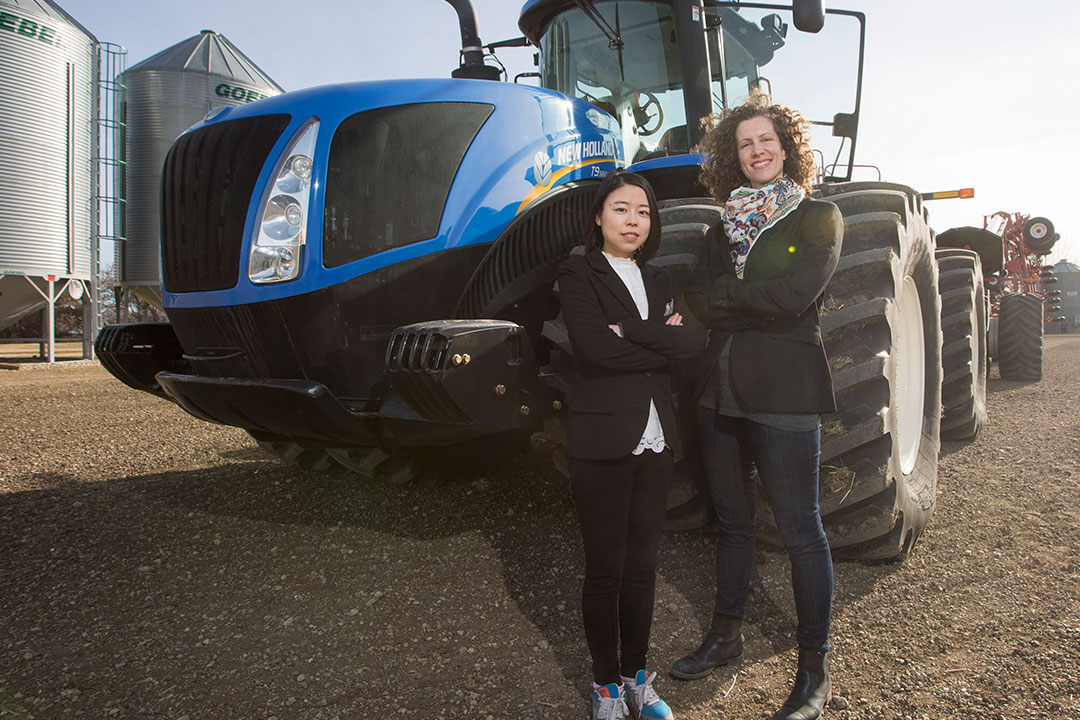
Vibrations can be bad for farmers’ backs
Days spent driving around on a tractor contribute to back problems for a significant number of farmers, University of Saskatchewan researchers have found.
By Federica GiannelliResearcher Catherine Trask and recent master’s graduate Xiaoke Zeng have found that farmers experience prolonged “body shock” when riding horses or driving farming machinery on uneven terrain during an average workday. Whole body vibration is a major risk factor for developing back pain, they say.
“Farmers are often unaware that body vibration from machinery use is a potentially harmful physical hazard,” said Trask, U of S Canada Research Chair in Ergonomics and Musculoskeletal Health.
Almost 20 per cent of Canadians are affected by back pain, costing the Canadian healthcare system up to $12 million per year. Compared to people in cities, people in rural areas are 30 per cent more likely to experience chronic back pain.
In a 2015 study on 2,600 Saskatchewan farmers, Trask’s team reported that almost 60 per cent experience low back pain, apparently a much higher incidence than in the general population. This causes farmers to reduce the amount of work they do daily in 30 per cent of the most severe cases — up to eight times more than in any other profession, a 2001 study on American farmers states.
“Low back disorders really impact farmers’ ability to do their jobs, especially lifting or carrying things around,” said Trask.
Zeng has also found that the type of vehicle and daily use of multiple machines changes the extent of farmers’ exposure to vibration.
She measured vibrations for tractors, grain trucks, pick-up trucks, combines, skid-steer loaders, ATVs, sprayers and swathers. Visiting 21 farms in 2015, she asked about 40 workers to mount special measuring equipment on their machinery seats.
“Skid-steer loaders and all-terrain vehicles showed the highest vibrations,” she said. “Combines for harvesting crops and sprayers showed the lowest.”
Zeng said farmers on small farms are more exposed to vibration doses daily because they are more likely to own machines with outdated suspension systems.
With a bachelor of science in preventive medicine from China, Zeng joined Trask’s team two years ago. Her goal was learning new tools to better promote workers’ health, a topic she became passionate about when she studied coal miners’ harmful exposure to dust in China.
To limit exposure to vibrations, Trask and Zeng advise farmers to:
- use newer seats for their vehicles, additional cushion pads and back supports.
- have hourly breaks for walking and stretching.
In another related preliminary study — the first to measure vibrations for work-related horse riding in Canada, Zeng found that the vibration level was even higher than for skid-steer loaders.
But Zeng said the effects may not be as harmful and more research is needed on the topic, noting that horses are still a common alternative to machines for ranching.
Funded by the Canada Research Chairs program and Saskatchewan Health Research Foundation, the team’s research on whole body vibration has been published in three journals.
Follow Trask on Twitter or visit the research group's website.
Federica Giannelli is a graduate student intern in the U of S research profile and impact unit.
This article first ran as part of the 2017 Young Innovators series, an initiative of the U of S Research Profile and Impact office in partnership with the Saskatoon StarPhoenix.

